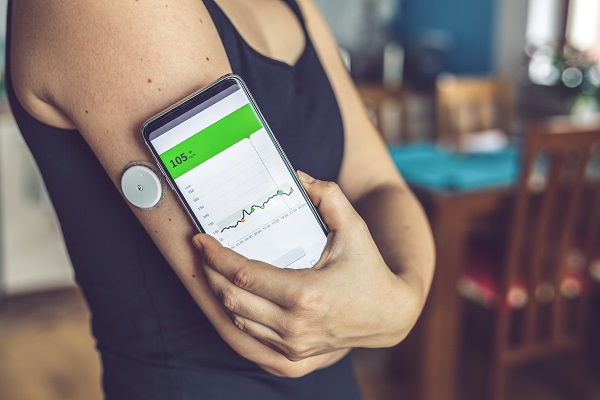By Sarah Garland
2021 marks the 100th anniversary of the discovery of insulin. As Canada reflects on this discovery and commemorates this milestone, it’s important to consider the future of diabetes management and highlight new research. CADTH — an independent agency that finds, assesses, and summarizes the research on drugs, medical devices, tests, and procedures — has conducted several reviews of diabetes technologies, most recently on systems for monitoring blood glucose and delivering insulin.
Hybrid Closed-Loop Insulin Delivery Systems for People with Type 1 Diabetes
Hybrid closed-loop systems consist of an insulin pump, a continuous glucose monitor, and a computer program that allows the pump and the monitor to communicate with each other and automatically calculate how much insulin is needed. It’s considered a hybrid system since the user still has to manually account for their insulin needs before eating and then manually confirm the amount of mealtime (bolus) insulin to be delivered. CADTH conducted a health technology assessment to compare hybrid closed-loop systems with other insulin delivery methods in people with type 1 diabetes.
CADTH found that these systems generally increase the amount of time a person is in their target blood glucose ranges compared with other insulin delivery methods. At least, this appears to be the case in the short term, for up to 6 months — there haven’t been any studies following research participants for longer than that. There also wasn’t research available to tell us which people with type 1 diabetes might benefit the most from hybrid closed-loop systems.
For people with diabetes and their caregivers, hybrid closed-loop systems can decrease the amount of time and energy spent on diabetes management. That means they can spend more time on other activities since the system can relieve some of the demands of monitoring blood glucose and technical tasks (i.e., calculating insulin needs). However, it takes time to develop trust in the system and adapt to new routines, and people may experience technical glitches and other technical issues (e.g., system maintenance).
Trial periods to ensure hybrid closed-loop systems are working well for new users could be considered. In addition, education, support, user-friendly devices, and understandable information are key to helping new users learn to use these systems effectively.
Flash Glucose Monitoring Systems in Pediatric Populations With Diabetes
Flash glucose monitoring systems involve a sensor inserted into a person’s skin that continuously takes blood glucose measurements and stores them for retrieval later on. A person may use flash glucose monitoring to determine their insulin needs and as an alternative or complement to other kinds of blood glucose testing.
CADTH summarized and critically appraised the evidence on flash glucose monitoring in children and adolescents. The majority of studies suggest that, when compared with self-monitoring blood glucose techniques, flash glucose monitoring may improve some outcomes for this population group — mainly quality of life, patient satisfaction, and confidence with testing. But the evidence was mixed on clinical outcomes such as hemoglobin A1C (a biomarker for diabetes), amount of time in the target blood glucose range, and side effects — some studies found that flash glucose monitoring was associated with improved outcomes, while others found no association.
To get a sense of the clinical effectiveness and accuracy of flash glucose monitoring and continuous glucose monitoring in acute care settings, including intensive care units, CADTH looked for the available evidence. (Continuous glucose monitoring devices report glucose measurements in real time.) Most studies found that, when compared with point-of-care blood glucose testing, flash glucose and continuous glucose monitoring increased the amount of time spent in the target glucose range, improved average daily blood glucose levels, and reduced the number of events where blood glucose was too high or too low. However, there were a couple of studies that didn’t find that these systems had a significant impact on these outcomes.
The studies were also mixed when it came to the accuracy of flash glucose and continuous glucose monitoring. So, we’re uncertain how accurate they are compared with other methods of testing blood glucose (e.g., by testing arterial, capillary, or biochemical serum).
There have been a couple of advantages to flash glucose and continuous glucose monitoring during the COVID-19 pandemic. Use of these systems within the hospital setting has allowed health care workers to minimize their contact with isolated hospitalized patients who need their blood glucose monitored, thereby also reducing the workers’ use of personal protective equipment.
These new technologies for monitoring blood glucose and delivering insulin hold promise, though there are still some evidence gaps. Improving the way people with diabetes monitor their blood glucose could both improve their health outcomes and give them more time and mental space to engage in their daily lives. Given how quickly technologies for diabetes management are being developed, who knows how diabetes will be managed after the next 100 years!
For more information, you can visit cadth.ca/evidence-bundles/evidence-diabetes-management for the latest evidence on diabetes, including the CADTH reports listed in this article. If you’d like to learn more about CADTH, visit cadth.ca, follow us on Twitter @CADTH_ACMTS, or speak to a Liaison Officer in your region: cadth.ca/Liaison-Officers.
Sarah Garland is a knowledge mobilization officer at CADTH.


